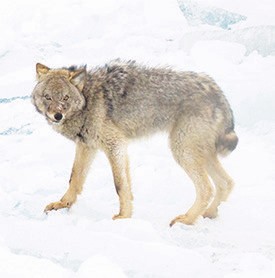In mid-March, the National Park Service released its environmental impact statement on wolf/ moose/vegetation management at Isle Royale National Park. On April 8, Michigan Tech University researchers completed their Isle Royale winter study of moose and wolves and confirmed that there are only 2 wolves left on the island while the moose population has risen to more than 1,300.
The winter study took place between January 22 and February 25 and was conducted by noted Michigan Tech professors Rolf Peterson and John Vucetich.
Since 2009 the wolf population has fallen by more than 90 percent. Each year since that drop-off the moose population has increased by an annual rate of 19 percent.
“If that growth rate persist, the moose population will double in size over the next three to five years,” states the report.
Last year there were three wolves, two adults and one pup. The pup died over the winter or in later fall. The two remaining wolves are believed to share a common mother and the remaining female is the daughter of the remaining male. They are estimated to be 6 and 8 years old. Most wolves living in the wild perish before the age of 5, so these two have so far beaten the odds.
In the early 1980s there were an estimated 50 wolves on the island. Disease and inbreeding have caused the population to all but disappear.
As far as the lone two wolves, the researchers said, “It is almost certainly too late to conduct genetic rescue. That is, a new wolf population would now have to be re-established if wolves are to remain an ecological force on the island.”
And because of their age and health the report states, “There are no options for mates.”
Wolf skeletons examined since 1994 have all exhibited problems with their vertebraes, including having extra vertebrae, and they also all have had abnormal rib cages.
As far as current moose approximations, the researchers say, “It is likely that the point estimate of 1,300 moose for 2016 is an underestimate,” and they suggest the population is probably closer to 1,440. Last year the winter count was 1,250.
This winter five sets of twins were observed, an increase over previous years. This is an indicator that the moose are well nourished and exposed to negligible rates of predation.
Absent predation by wolves, only severe winters will limit moose numbers, say Vucetich and Peterson.
“If the recent trend in growth continues for just three more years the moose population will approximate the level of the mid 1990s, just prior to the die-off in 1996. At that time the moose population had considerable impact on forest vegetation. Concerns remain that the upcoming increase in moose abundance will result in longterm damage to the health of Isle Royale’s vegetative community,” the two scientists conclude.
Due to the lack of wolves, beaver have also experienced a two-fold increase in beaver lodges on the island. Marten tracks were also observed. Since 1991 marten tracks have been seen in all but three years. Before that, signs of marten were completely absent from the island from 1959-1990. Red fox and snowshoe hare were also spotted, although in fewer numbers than the last couple of years.
If the National Park Service doesn’t reintroduce wolves to the island, and that is currently being thought over and debated, the longest predator/prey study conducted by man will end when the last two wolves die.
The only other hope is that there will be a winter cold enough to form an ice bridge and wolves will walk from the mainland to the island and stay. Chances are slim for that to happen, however, as only three ice bridges have formed in the last 18 years.



Loading Comments